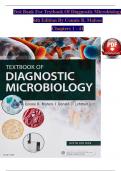Test Bank For Textbook Of Diagnostic Microbiology
6th Edition By Connie R. Mahon
Chapters 1 - 41
, Mahon:eTextbookeofeDiagnosticeMicrobiology,e6theEditioneTesteBank
Tableeofecontents
Parte1:eIntroductionetoeClinicaleMicrobiology
Chaptere1.eBacterialeCelleStructure,ePhysiology,eMetabolism,eandeGenetics
Chaptere2.eHost-ParasiteeInteraction
Chaptere3.eTheeLaboratoryeRoleeineInfectioneControl
Chaptere4.eControleofeMicroorganisms:eDisinfection,eSterilization,eandeMicrobiologyeSafety
Chaptere5.ePerformanceeImprovementeinetheeMicrobiologyeLaboratory
Chaptere6.eSpecimeneCollectioneandeProcessing
Chaptere7.eMicroscopiceExaminationeofeMaterialsefromeInfectedeSites
Chaptere8.e UseeofeColonyeMorphologyeforetheePresumptiveeIdentificationeofeMicroorganisms
Chaptere9.e BiochemicaleIdentificationeofeGram-NegativeeBacteria
Chaptere10.eImmunodiagnosiseofeInfectiouseDiseases
Chaptere11.eApplicationseofeMoleculareDiagnostics
Chaptere12.eAntibacterialeMechanismseofeActioneandeBacterialeResistanceeMechanisms
Chaptere13.eAntimicrobialeSusceptibilityeTesting
Parte2:eLaboratoryeIdentificationeofeSignificanteIsolates
Chaptere14.eStaphylococci
Chaptere15.eStreptococcus,eEnterococcus,eandeOthereCatalase-Negative,eGram-PositiveeCocci
Chaptere16.eAerobiceGram-PositiveeBacilli
Chaptere17.eNeisseriaeSpecieseandeMoraxellaecatarrhalis
Chaptere18.eHaemophilus,eHACEK,eLegionellaeandeOthereFastidiouseGram-NegativeeBacilli
Chaptere19.eEnterobacteriaceae
Chaptere20.eVibrio,eAeromonas,eandeCampylobactereSpecies
Chaptere21.eNonfermentingeandeMiscellaneouseGram-NegativeeBacilli
Chaptere22.eAnaerobeseofeClinicaleImportance
Chaptere23.eTheeSpirochetes
Chaptere24.eChlamydia,eRickettsia,eandeSimilareOrganisms
Chaptere25.eMycoplasmaeandeUreaplasma
Chaptere26.eMycobacteriumetuberculosiseandeNontuberculouseMycobacteria
Chaptere27.eMedicallyeSignificanteFungi
Chaptere28.eDiagnosticeParasitology
Chaptere29.eClinicaleVirology
Chaptere30.eAgentseofeBioterroreandeForensiceMicrobiology
Chaptere31.eBiofilms:eArchitectseofeDisease
Parte3:eLaboratoryeDiagnosiseofeInfectiouseDiseases:eandeOrganeSystemeApproachetoeDiagnosticeMicrobiolog
y
Chaptere32.eUppereandeLowereRespiratoryeTracteInfections
Chaptere33.eSkineandeSofteTissueeInfections
Chaptere34.eGastrointestinaleInfectionseandeFoodePoisoning
Chaptere35.eInfectionseofetheeCentraleNervouseSystem
Chaptere36.eBacteremiaeandeSepsis
Chaptere37.eUrinaryeTracteInfections
Chaptere38.eGenitaleInfectionseandeSexuallyeTransmittedeInfections
Chaptere39.eInfectionseineSpecialePopulations
Chaptere40.eZoonoticeDiseases
Chaptere41.eOculareInfections
-
,Chaptere01:eBacterialeCelleStructure,ePhysiology,eMetabolism,eandeGeneticse
Mahon:eTextbookeofeDiagnosticeMicrobiology,e6theEditioneTesteBank
MULTIPLEeCHOICE
1. Toesurvive,emicrobialeinhabitantsehaveelearnedetoeadaptebyevaryingealleofetheefollowing,eexcept
a. growtherate.
b. growtheinealleatmosphericeconditions.
c. growtheateparticularetemperatures.
d. bacterialeshape.
ANSWER:e D
Theechapterebeginsebyediscussingetheewayemicrobialeinhabitantsehaveehadetoeevolveetoesurviveei
nemanyedifferentenicheseandehabitats.eItediscusseseslowegrowers,erapidegrowers,eandereplicatio
newithescarceeoreabundantenutrients,eunderedifferenteatmosphericeconditions,etemperatureerequi
rements,eandecellestructure.eBacterialeshapeeaseaeformeofeevolutioneisenotediscussed.
OBJ:e Levele2:eInterpretation
2. Whoewaseconsideredetheefathereofeprotozoologyeandebacteriology?
a. AntonevaneLeeuwenhoek
b. LouisePasteur
c. CarleLandsteiner
d. MichaeleDouglas
ANSWER:e A
TheebookediscusseseAntonevaneLeeuwenhoekeasetheeinventoreofetheemicroscopeeandetheefirstep
ersonetoeseeethee“beasties.”eSoetheyedubbedehimetheefathereofeprotozoologyeandebacteriology.eT
heeotherethreeeindividualsewereenotediscussed.
OBJ:e Levele1:eRecall
3. Prokaryoticecellsehaveewhicheofetheefollowingestructureseinetheirecytoplasm?
a. Golgieapparatus
b. Ribosomes
c. Mitochondria
d. Endoplasmicereticulum
ANSWER:e B
Alletheestructureselistedeareefoundeineeukaryoticecells,ebuteribosomeseareetheeonlyeonesethatea
pplyetoeprokaryoticecells.
OBJ:e Levele1:eRecall
4. ThiseformeofeDNAeisecommonlyefoundeineeukaryoticecells.
a. Linear
b. Circular
c. Plasmid
d. Colloid
Ultimatestudyguide2021@gmail.com
TestBanks/eSolutioneManualseandeExam
, ANSWER:e A
CirculareandeplasmideDNAeareeusuallyefoundeonlyeinebacteria,enoteeukaryoticecells.eColloideisea
epropertyeofeproteinemoleculeseandeisenoteassociatedewithenucleotides.
OBJ:e Levele1:eRecall
5. Theenuclearemembraneeineprokaryoteseis
a. missing.
b. impenetrable.
c. aeclassicemembrane.
d. aelipidebilayeremembrane.
ANSWER:e A
Prokaryoticecellsedoenotehaveeanyemembrane-
boundestructureseinetheecytoplasmeincludingeaestructuredenucleus.
OBJ:e Levele1:eRecall
6. Aemicroorganismethateiseaeunicellulareorganismeandelackseaenuclearemembraneeandetruee
nucleusebelongsetoewhicheclassification?
a. Fungi
b. Bacteria
c. Algae
d. Parasite
ANSWER:e B
Fungi,ealgae,eandeparasiteseareeunicellulareeukaryoticeorganismsethatecontaineaetrueenucleus.e
Bacteriaeareeprokaryoticeandedoenotecontaineaetrueenucleuseorenuclearemembrane.
OBJ:e Levele1:eRecall
7. Inetheelaboratory,etheeclinicalemicrobiologisteiseresponsibleeforealletheefollowing,eexcept
a. isolatingemicroorganisms.
b. selectingetreatmenteforepatients.
c. identifyingemicroorganisms.
d. analyzingebacteriaethatecauseedisease.
ANSWER:e B
Clinicalemicrobiologistsedoenoteselectetheetreatmenteforepatients.eTheyeprovideetheedoctorewithet
heenameeofetheeorganismeandetheeantibioticsethatecanekilletheebacteria,ebutenoteinetheefinaleselect
ioneofetreatmenteprotocols.
OBJ:e Levele2:eRecall
8. Whateenablesetheemicrobiologistetoeselectetheecorrectemediaeforeprimaryecultureeandeoptimizeet
heechanceeofeisolatingeaepathogeniceorganism?
a. Determiningestainingecharacteristics
b. Understandingetheecellestructureeandebiochemicalepathwayseofeaneorganism
c. Understandingetheegrowtherequirementseofepotentialepathogenseatespecificebodyesite
d. Knowingetheedifferencese inecellewallseofeparticularebacteria
ANSWER:e C




